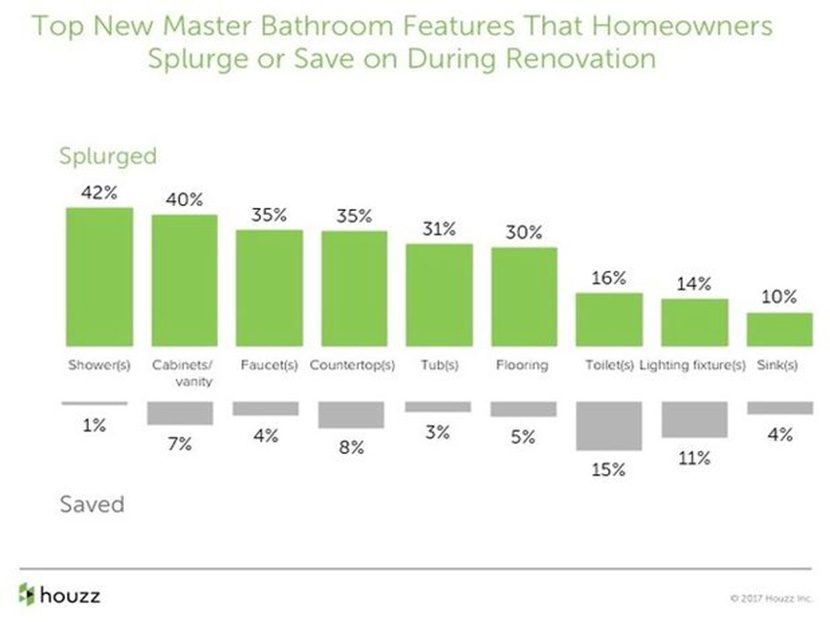Houzz Study Reveals Master Bathroom Trends

Showers are the most common splurge during master bathroom renovations, according to the 2017 U.S. Houzz Bathroom Trends Study.
The survey of more than 1,200 U.S. homeowners using Houzz who are in the midst of, are planning, or recently completed a master bathroom project, found that of those upgrading their master shower (81 percent), more than half increase its size (55 percent). The demand for high-tech features like mood lighting or digital controls is also on the rise in master bathrooms compared to the year prior (12 percent in 2017 versus nine percent in 2016).
Over a quarter of homeowners remove their bathtub (27 percent) during master bathroom renovations to make room for a larger shower (91 percent). Statement showers are not only bigger in master bathrooms, but also include high-end features for three in four homeowners (73 percent), such as rainfall showerheads (55 percent), dual showers (24 percent), curbless showers (21 percent) and body sprays (18 percent).
“This year’s Bathroom Trends Study sheds light on two key trends in master bathrooms, showers as a focal point and the growing role of high-tech features in bathroom products,” said Nino Sitchinava, principal economist at Houzz.
The national average for a major remodel of larger master bathrooms (more than 100 square feet) is $21,000, however budgets vary widely across the country. In the San Francisco metro area, the most expensive of the top 20 U.S. metro areas, this number jumps to $34,100, whereas in Miami, the least expensive metro area, this number drops down to $16,900.
The scope of master bathroom remodels also varies by age, with Baby Boomers (55+) spending on average $22,800 for a major remodel of a larger bathroom, nearly twice as much as Millennial homeowners under 35 ($12,500). Baby Boomers are significantly more likely to integrate accessibility features in new master showers (73 percent), toilets (72 percent) and bathtubs (40 percent).
Generational differences also include color preference. White countertops and cabinets and gray flooring and walls are significantly more likely to appear in Millennial homeowners’ renovated master bathrooms than in those of Baby Boomers. Meanwhile, Baby Boomers are more likely to opt for medium wood tone cabinets, while Gen-Xers (35-54) prefer dark wood tones.
Additional master bathroom trends include:
- Getting Social: Even more homeowners admit to using mobile devices in their bathrooms at least once per week, compared to last year (64 percent in 2017 versus 58 percent in 2016). Top activities include emailing (40 percent), texting/IMing (32 percent), talking on the phone (27 percent) and catching up on social media (26 percent). Social media use in the bathroom more than doubles for Millennials (54 percent).
- Tech for Toilets: Homeowners are getting an upgrade with high-tech toilets showing a 26 percent increase year over year (29 percent in 2017 versus 24 percent in 2016).
- Budgeting for Priorities: Beyond showers, other features where people tend to splurge include cabinets and vanities (40 percent), countertops (35 percent) and faucets (35 percent).
- Shades of White and Gray: White continues to gain popularity in renovated master bathrooms, with even more countertops and walls appearing in white this year (40 percent and 19 percent, respectively) compared to the 2016 findings. These features are increasingly contrasted against gray walls and cabinet surfaces (35 percent and 14 percent, respectively).
- Time for a Change: Nine in ten renovating homeowners change the style of their master bathroom during upgrades (90 percent). The most popular styles include contemporary (25 percent), transitional (17 percent) and modern (15 percent).
- Hire a Pro: Considering the scope of master bathroom renovations, 86 percent of renovating homeowners hire a home professional for their master bathroom renovation, with the majority bringing in a general contractor or bathroom remodeler to help with overall project management (52 percent and 19 percent, respectively).
You can download the full 2017 U.S. Houzz Bathroom Trends Study here.




